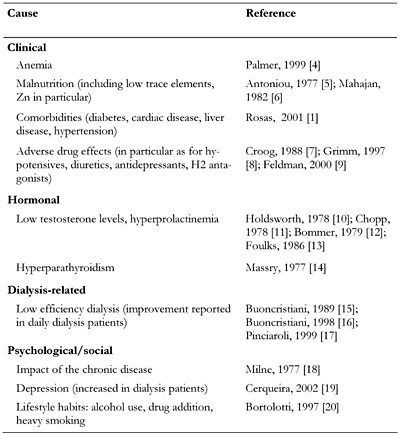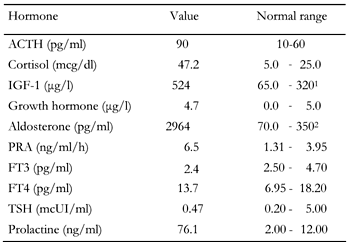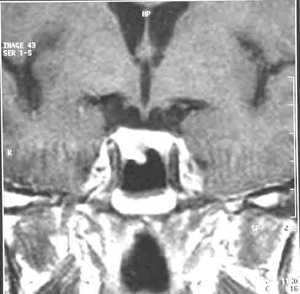Case Report
| Rev Diabet Stud,
2006,
3(4):200-204 |
DOI 10.1900/RDS.2006.3.200 |
Prolactinoma in a Diabetic Dialysis Patient with Erectile Dysfunction: A Difficult Differential Diagnosis
Giorgina B. Piccoli1, Francesca Bermont1, Andrea Magnano1, Giorgio Soragna1, Massimo Terzolo2
1Nephrology Unit, Department of Internal Medicine, University of Turin, Dialisi e Trapianto, Corso Bramante 88, 10126 Torino, Italy.
2Department of Internal Medicine, University of Turin, Polo San Luigi, Orbassano, Turin, Italy.
Address correspondence to: Giorgina B. Piccoli, e-mail: giorgina.piccoli@unito.it
Keywords: prolactinoma, diabetic nephropathy, erectile dysfunction, hemodialysis, hyperprolactinemia
Abstract
Dialysis patients often suffer from erectile dysfunction. The prevalence of this symptom in the context of dialysis is as high as 90%. Diabetes, diffuse vascular disease and pharmacological therapy are attendant causes of this condition, severely impairing the quality of life. Due to the high frequency of erectile dysfunction in uremic patients, minimalist diagnostic approaches are often used. Nevertheless, a careful differential diagnosis is also warranted in well dialyzed patients to identify causes and corrigible patterns. The case reported here exemplifies this critical issue. A 44 year old obese diabetic patient complained about the recent onset of erectile dysfunction. On examination, the penile echo-Doppler was normal, and suggested a cause other than dia-betic vascular disease. The high dialysis efficiency (daily hemodialysis, flexible schedules, EKRc from 15 to 25 ml/min) warranted the same diagnostic work-up as would adopted for non-uremic patients. Whilst the rising prolactine level (76.1 µg/l and 129 ng/ml) was still in the range commonly found in dialysis patients, a nuclear magnetic resonance examination was carried out and led to the identification of prolactinoma. Therapy with cabergoline was found effective and sexual potency was restored. Normalization of hormonal patterns followed within 2 months. This is the first case so far reported in a daily dialysis patient. It underlines the importance of a non-minimalist approach to the problem of sexual disorders in renal replacement therapy (RRT) patients, at least when dialysis efficiency is high and onset is rapid. It also suggests considering prolactinoma as an emerging diagnosis in the general population, which can be detected by the use of sensitive imaging techniques in the differential diagnosis of this condition.
Introduction
Erectile dysfunction is a commonly reported problem in patients with end-stage renal disease. It has a prevalence ranging from approximately 50% to over 90% within the group of patients having renal disease [1-4]. Several clinical and psychological factors were considered to be important in the pathogenesis of this disorder, which severely affects the quality of life of our patients. The main factors are summarized in Table 1 [1, 4-20].
Table
1.
Main causes of erectile dysfunction in dialysis patients |
|
 |
 |
All these factors are in some way peculiar to dialysis patients, and are only partially shared by the other subgroups of individuals with chronic diseases, such as severe cardiac or liver disease. The presence of erectile dysfunction is less frequent in the non-uremic population, in contrast to dialysis patients where it is generally expected. However, the condition is sometimes in danger of being overlooked, due to the "background noise" of uremia symptoms.
The case reported here exemplifies these diagnostic problems and justified a detailed differential diagnosis. In particular, it points to prolactinoma, an emerging disorder detectable by sensitive imaging techniques [21]. As these techniques are not generally applied the case should also extend the context of disorders in which its usage is beneficial and necessary.
The case
A 44 year old Caucasian male, on dialysis since the age of 41, complained of erectile dysfunction. His dialysis treatment was started on a thrice weekly conventional schedule. Approximately one year later he was switched to a daily home hemodialysis. This led to the patient's full rehabilitation, insomuch as he was able to return to full time work. His clinical history was remarkably silent except for juvenile obesity. Diagnosis of early onset type 2 diabetes was made at the start of dialysis, together with hypertension. There was no family history of MODY. Dialysis was started as an emergency treatment. Note that based on the finding of an isolated microhematuria in a single urine test at the age of 18 a chronic glomerulonephritis was suspected. An alternative explanation could have been the presence of diabetic nephropathy or another nephrosclerotic disease.
At age 42, a few months after the start of daily dialysis, an endocrinologic/metabolic screening was carried out due to the presence of pathological obesity (BMI = 34) and poor metabolic control. These data are shown in Table 2. The complex and multiple metabolic alterations were interpreted as the combined effect of diabetes, obesity and uremia. Indeed, the diabetes control was relatively poor, with glycated albumin ranging from 8% to over 11% and very low compliance to diet and drug therapy. Diabetic background retinopathy, neuropathy and peripheral ulcers on both feet were present. In contrast, dialysis efficiency was very good. The patient performed home daily dialysis with very flexible schedules (no less than 6 sessions per wk, no less than 12 h, and often up to 18 h of dialysis per wk, with a consequent equivalent urea clearance (EKR) of 15-25 ml/min according to the Casino model).
Table
2.
Serum hormonal levels of the patient a few months after the switch to daily dialysis |
|
 |
 |
Legend:
ACTH: adrenocorticotropic hormone. IGF-1: insulin-like growth factor-1. PRA: plasma renin activity. FT3: free triiodothyronine. FT4: free thyroxine. TSH: thyroid-stimulating hormone. 1 Normal range for persons of age 40-59 yr. 2 Normal range for response to orthostatism. |
|
Despite the poor diabetes control, the patient did not complain of any problems in sexual functioning until the age of 44. Anemia control was very good. Hemoglobin was at 12.3 g/dl without erythropoietin therapy. Support therapy consisted of calcium carbonate, magnesium-aluminum hydroxide, folic acid, vitamin B12, lansoprazole and ferrous gluconate. A urological examination suggested the presence of a non-specific problem related to diabetes and dialysis. However, the penis echo-Doppler was normal.
Following the advice of the consultant endocrinologist, prolactin levels were tested repeatedly (129 ng/ml, with low testosterone levels of 0.73 ng/ml). Subsequently, a nuclear magnetic resonance imaging of the hypophysis was carried out. The results suggested the presence of a microprolactinoma (Figure 1). Subsequently, therapy with cabergoline was started (0.5 mg twice weekly). The treatment showed rapid clinical response and the problem was overcome within 2 months.
 |
 |
Figure 1. MRT image showing microprolactinoma in the hypothalamus of a diabetic dialysis patient with erectile dysfunction. |
|
By the last endocrinological tests, prolactine levels had been returned to normal, as had the overall hormonal pattern (LH 3.2 mU/ml, FSH 4.0 mU/ml, prolactine 2.5 ng/ml, testosterone 2.49 ng/ml, with free testosterone 11.2 pg/ml). Unfortunately, seven months after diagnosis the patient died of an acute vascular accident, superimposed on massive gastric bleeding.
Discussion
Approximately 200 articles have been published on erectile dysfunction and dialysis since the start of renal replacement therapy [22, 23] and the research work has contributed to great advances in erythropoietin therapy [24] to the new "sidenafil era" [25-28]. However, none of the articles report on prolactinoma diagnosed in an uremic patient in this context.
Our patient displayed a full set of risk conditions for the development of erectile dysfunction. He was diabetic and on dialysis. He had signs of neuropathy (feet ulcers), microvascular disease (retinopathy, nephropathy), and a poor metabolic control. In accordance with the usual minimalist approach to treatment for this common condition, the andrologist only suggested testing penile echo-Doppler, followed by referral to a psychiatric counseling practice. However, there were discrepancies in the observable aspects of the case. Given the high effective dialysis (EKRc 15-25 ml/min) and results of previous studies [15-17], sexual potency should have been restored. Against this, the sudden appearance of erectile dysfunction, for which there was no previous report, and a lower dialysis effectiveness, seemed unlikely to be a mere effect of uremia. Furthermore, the rapid onset of erectile dysfunction suggested a cause unrelated to dialysis.
The simultaneous appearance of diabetic neuropathy gave a hint. In fact, while diabetic neuropathy is an incalculable condition, the acute forms are usually painful and the erectile impotence of diabetic patients is usually the result of a chronic microvascular and neuropathic involvement [29-30]. The patient dismissed any causes due to encumbering life situations, voluptuary habits, alcohol abuse or variations in drug therapies. Nor were they implied by the clinical history or blood tests (no variation in liver enzymes or in blood pressure). On this basis, subsequent diagnosis followed usual practices when dealing with the non-dialysis dependent population, with particular attention to the hormonal profile.
Another interesting but confusing aspect was the high prolactine level. In fact, hyperprolactinemia is also very common in dialysis patients, but the relationship between high levels and symptoms is not straightforward [31]. A relationship between high dialysis efficiency and high prolactine levels, as observed in our patient, has not been described thus far. The same applies for the high levels of other middle molecules or hormones, such as parathyroid hormones. Dialysis-related hyperprolactinemia was not obvious from the beginning of the treatment. It would therefore be beneficial to define the scope of this infrequently observed disorder against other diseases.
In the case in question, the further diagnostic follow-up was based on the indications commonly given in the overall population, choosing the lower prolactine level (100 ng/ml) at which pituitary imaging is usually indicated. Note that prolactinoma has an estimated prevalence of 100 persons per million population. It is increasingly being diagnosed in the overall population, probably due to both the combination of higher awareness and the improved resolution from imaging techniques [21].
In summary, prolactinoma should be included in the differential diagnosis of erectile dysfunction and of severe hyperprolactinemia of dialysis patients. While cabergoline therapy was not linked to an improvement of the sexual problems in dialysis-related hyperprolactinemia, its role may be crucial in primary endocrinological diseases, among the few curable causes of this life-quality impairing disorder.
References
- Rosas SE, Joffe M, Franklin E, Strom BL, Kotzker W, Brensinger C, Grossman E, Glasser D, Feldman HI. Prevalence and determinants of erectile dysfunction in hemodialysis patients. Kidney Int 2001. 59:2259-2266. [DOD]
- Turk S, Karalezli G, Tonbul HZ, Yildiz M, Altintepe L, Yildiz A, Yeksan M. Erectile dysfunction and the effects of sildenafil treatment in patients on haemodialysis and continuous ambulatory peritoneal dialysis. Nephrol Dial Transplant 2001. 6:1818-1822. [DOD] [CrossRef]
- Procci WR, Goldstein DA, Adelstein J, Massry SG. Sexual dysfunction in the male patient with uremia: a reappraisal. Kidney Int 1981. 19(2):317-323. [DOD]
- Palmer BF. Sexual dysfunction in uremia. J Am Soc Nephrol 1999. 10:1381-1388. [DOD]
- Antoniou LD, Shalhoub RJ, Sudhakar T, Smith JC Jr. Reversal of uraemic impotence by zinc. Lancet 1977. 2:895-898. [DOD] [CrossRef]
- Mahajan SK, Abbasi AA, Prasad AS, Rabbani P, Briggs WA, McDonald FD. Effect of oral zinc therapy on gonadal function in hemodialysis patients. A double-blind study. Ann Intern Med 1982. 97(3):357-361. [DOD]
- Croog SH, Levine S, Sudilovsky A, Baume RM, Clive J. Sexual symptoms in hypertensive patients. A clinical trial of antihypertensive medications. Arch Intern Med 1988. 148(4):788-794. [DOD] [CrossRef]
- Grimm RH Jr, Grandits GA, Prineas RJ, McDonald RH, Lewis CE, Flack JM, Yunis C, Svendsen K, Liebson PR, Elmer PJ. Long-term effects on sexual function of five antihypertensive drugs and nutritional hygienic treatment in hypertensive men and women. Treatment of Mild Hypertension Study (TOMHS). Hypertension 1997. 29:8-14. [DOD]
- Feldman HA, Johannes CB, Derby CA, Kleinman KP, Mohr BA, Araujo AB, McKinlay JB. Erectile dysfunction and coronary risk factors: prospective results from the Massachusetts male aging study. Prev Med 2000. 30(4):328-338. [DOD] [CrossRef]
- Holdsworth SR, De Kretser DM, Atkins RC. A comparison of hemodialysis and transplantation in reversing the uremic disturbance of male reproductive function. Clin Nephrol 1978. 10:146-150. [DOD]
- Chopp RT, Mendez R. Sexual function and hormonal abnormalities in uremic men on chronic dialysis and after renal transplantation. Fertil Steril 1978. 29(6):661-666. [DOD]
- Bommer J, Ritz E, Del Pozo E, Bommer G. Improved sexual function in male haemodialysis patients on bromocriptine. Lancet 1979. 2:496-497. [DOD] [CrossRef]
- Foulks CJ, Cushner HM. Sexual dysfunction in the male dialysis patient: pathogenesis, evaluation, and therapy. Am J Kidney Dis 1986. 8(4):211-222. [DOD]
- Massry SG, Goldstein DA, Procci WR, Kletzky OA. Impotence in patients with uremia: a possible role for parathyroid hormone. Nephron 1977. 19:305-310. [DOD]
- Buoncristiani U. Dramatic improvement in clinical-metabolic parameters and quality of life with daily dialysis. Int J Artif Org 1989. 12:133-136. [DOD]
- Buoncristiani U. Fifteen years of clinical experience with daily haemodialysis. Nephrol Dial Transplant 1998. 13:148-151. [DOD] [CrossRef]
- Pinciaroli AR. Hormonal changes in daily hemodialysis. Semin Dial 1999. 12:455-461. [DOD] [CrossRef]
- Milne JF, Golden JS, Fibus L. Sexual dysfunction in renal failure: a survey of chronic hemodialysis patients. Int J Psych Med 1977. 8:335-345. [DOD]
- Cerqueira J, Moraes M, Glina S. Erectile dysfunction: prevalence and associated variables in patients with chronic renal failure. Int J Impot Res 2002. 14(2):65-71. [DOD] [CrossRef]
- Bortolotti A, Parazzini F, Colli E, Landoni M. The epidemiology of erectile dysfunction and its risk factors. Int J Androl 1997. 20(6):323-334. [DOD] [CrossRef]
- Jones TH. The management of hyperprolactinaemia. Br J Hosp Med 1995. 53:374-378. [DOD]
- Gral T, Sokol A, Rubini ME. Some medical problems of chronic hemodialysis. Isr J Med Sci 1967. 3(1):14-27. [DOD]
- Harari A, Munitz H, Wijsenbeek H, Levi J, Steiner M, Rosenbaum M. Psychological aspects of chronic haemodialysis. Psychiatr Neurol Neurochir 1970. 74(3):219-223. [DOD]
- Schaefer RM, Kokot F, Kuerner B, Zech M, Heidland A. Normalization of serum prolactin levels in hemodialysis patients on recombinant human erythropoietin. Int J Artif Org 1989. 12:445-449. [DOD]
- Seibel I, Poli De Figueiredo CE, Teloken C, Moraes JF. Efficacy of oral sildenafil in hemodialysis patients with erectile dysfunction. J Am Soc Nephrol 2002. 13:2770-2775. [DOD] [CrossRef]
- Turk S, Guney I, Altintepe L, Tonbul Z, Yildiz A, Yeksan M. Quality of life in male hemodialysis patients. Role of erectile dysfunction. Nephron Clin Pract 2004. 96(1):C21-C27. [DOD] [CrossRef]
- Lew SL, Piraino B. Quality of life and psychological issues in peritoneal dialysis patients. Semin Dial 2005. 18:119-123. [DOD] [CrossRef]
- Soykan A, Boztas H, Kutlay S, Ince E, Nergizoglu G, Dilekoz AY, Berksunn O. Do sexual dysfunctions get better during dialysis? Results of a six-month prospective follow-up study from Turkey. Int J Impot Res 2005. 17:359-363. [DOD] [CrossRef]
- Dunsmuir WD, Holmes SA. The aetiology and management of erectile, ejaculatory, and fertility problems in men with diabetes mellitus. Diabet Med 1996. 13(8):700-708. [DOD] [CrossRef]
- Dey J, Shepherd MD. Evaluation and treatment of erectile dysfunction in men with diabetes mellitus. Mayo Clin Proc 2002. 77(3):276-282. [DOD]
- Ramot Y, Rapoport MJ, Hagag P, Wysenbeek AJ. A study of the clinical differences between women and men with hyperprolactinemia. Gynecol Endocrinol 1996. 10(6):397-400. [DOD]
|